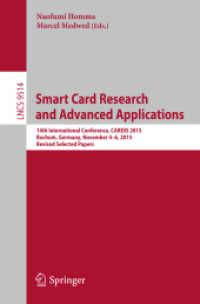Full Description
Neurobiology of Infectious Diseases covers mechanisms underlying infectious diseases. It is divided into six distinct sections, beginning with the foundations of Neuroinfection. This section includes chapters on the role microbiota-gut-brain axis and specialized blood-neuronal barriers play in neurobiology of infectious diseases. The next three sections detail various bacterial infections, parasitic infections, viral infections, and fungal infections of the central nervous system. The last section reviews the proteins and other peripheral mediators that affect the central nervous system. Internationally contributed by experts in the field this book sets the foundation of neurobiology and infectious disease.
Neurobiology is the study of cells of the nervous system and the organization of these cells into functional circuits that process information and mediate behavior. Current research is vital for determining pharmaceutical and medicinal treatments for neurological disorders, psychiatric disorders and diseases.
Contents
Part I - Foundations of Neuroinfection
1. Anatomical Organization of central nervous system (CNS)
2. The enteric nervous system's (ENS) impact on the neurobiology of infectious diseases
3. The role of the microbiota-gut-brain axis on the neurobiology of infectious diseases
4. The role and function of specialized blood-neuronal barriers: Blood-CSF, blood-retinal, blood-spinal cord, blood-labyrinth, blood-nerve barriers, and blood-brain barrier (BBB)
5. Neuroimmune interactions in the neurobiology of infectious diseases
6. The routes and mechanisms of microbial translocation to the central nervous system
Part II - Bacterial Infections Of CNS
7. Brain infections, encephalitis, and meningitis: Streptococcus pneumoniae
8. Brain infections, encephalitis, and meningitis: Neisseria meningitidis
9. Brain infections, encephalitis, and meningitis: Streptococcus agalactiae
10. Brain infections, encephalitis, and meningitis: Mycobacterium tuberculosis
11. Neurosyphilis
12. Brain infections, encephalitis, and meningitis: Lyme disease - Lyme borreliosis
13. Brain infections, encephalitis, and meningitis: Brucelosis
14. Brain infections, encephalitis, and meningitis: Listeria monocytogenesis - Listeriosis
15. Sepsis-associated encephalopathy: Understanding the brain dysfunction in sepsis
Part III - Parasitic Infections Of CNS
16. African trypanosomiasis: Comprehending the parasite pathogenesis in the brain
17. Cerebral malaria: Understanding the parasite pathogenesis in the brain
18. Neurocysticercosis
19. Free-living amoebae: Pathogens and the central nervous system (CNS) disease
20. Pathophysiological mechanisms of Toxoplasma gondii infection in the central nervous system (CNS)
Part IV - Virus Infections Of CNS
21. HIV-infected human brain: Implications in HIV infection and immune response
22. SARS-CoV-2 and nervous system: From pathogenesis of disease to clinical manifestations
23. The neurobiology of herpes simplex virus infection
24. Zika virus: Infection of the central nervous system (CNS)
25. Dengue fever and its neurological complications
26. Japanese encephalitis
27. West Nile viruses: Infection of the central nervous system (CNS)
28. Tick-borne encephalitis (TBE)
29. Chikungunya virus: Infection of the central nervous system
Part V- Fungal Infections Of CNS
30. Brain infections, encephalitis, and meningitis: Cryptococcus sp.
31. Central nervous system infection due to Histoplasma capsulatum
32. Brain infections, encephalitis, and meningitis: Coccidioides sp.
33. Brain infections, encephalitis, and meningitis: Candida sp.
Part VI - Proteins and other peripheral mediators that affect the CNS
34. Overview of human transmissible spongiform encephalopathies
35. Prion-like proteins in health and disease
36. Autoimmune encephalitis
37. Encephalitis: from mechanisms to management







